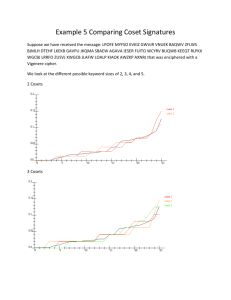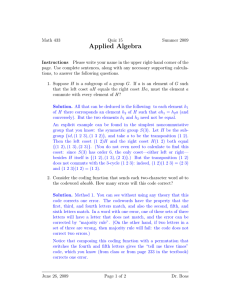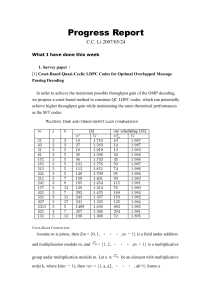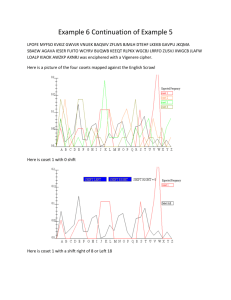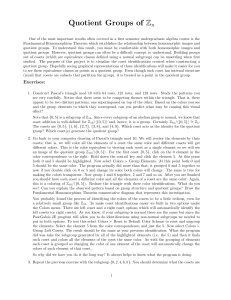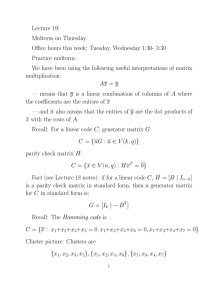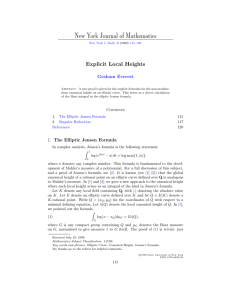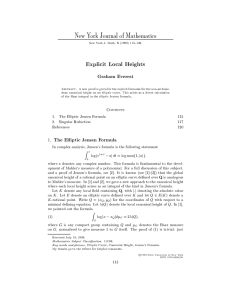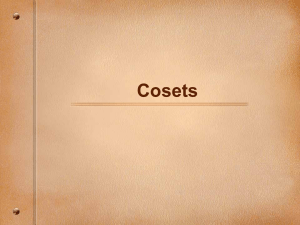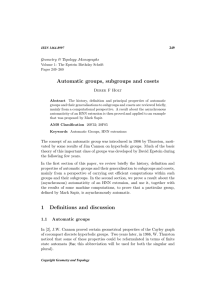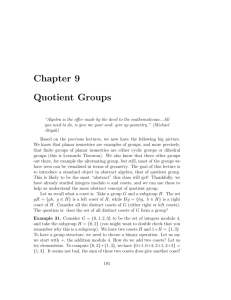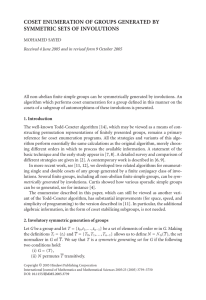Jodie
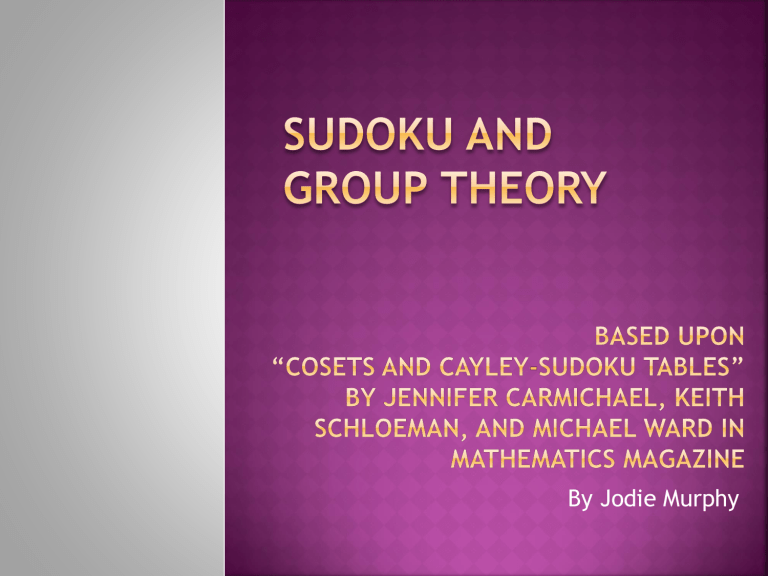
By Jodie Murphy
A number can appear only once on each row, column, and region (block)
9 3 6 1 4 7 2 5 8
1 4 7 2 5 8 3 6 9
2 5 8 3 6 9 4 7 1
3 6 9 4 7 1 5 8 2
4 7 1 5 8 2 6 9 3
5 8 2 6 9 3 7 1 4
6 9 3 7 1 4 8 2 5
7 1 4 8 2 5 9 3 6
8 2 5 9 3 6 1 4 7
Sound like an operation table (a Cayley table)?
A number can appear only once on each row, column, and region (block)
9 3 6 1 4 7 2 5 8
1 4 7 2 5 8 3 6 9
2 5 8 3 6 9 4 7 1
3 6 9 4 7 1 5 8 2
4 7 1 5 8 2 6 9 3
5 8 2 6 9 3 7 1 4
6 9 3 7 1 4 8 2 5
7 1 4 8 2 5 9 3 6
8 2 5 9 3 6 1 4 7
Sound like an operation table (a Cayley table)?
The difference between a Cayley table and a
Sudoku table resides in the regions.
Can the order of the rows and columns be altered to satisfy the rule that there is a unique group element (number) in each region?
Put the left cosets as the column headings and the right coset representatives as the row headings. This partitions the table into sets of left cosets.
Alternatively you can flip the table and put the right cosets as the column headings and the left coset elements as the rows.
This organization partitions the table into right cosets.
Examine cyclic subgroup generated by:
< 3 >={9,3,6}
Right coset
< 3 >+1
< 3 >+2
< 3 >+3
= Set =
={1,4,7}=
={2,5,8}=
={3,6,9}=
Left coset
1+< 3 >
2+< 3 >
3+< 3 >
Note: Generating more will start repeating these cosets.
For example: 4+<3>= {13, 7, 10} = {4, 7, 1} = <3>+4
Each block is a partition containing complete left coset representations.
3
4
5
9
1
2
6
7
8
{9 3 6}
Right Cosets
{1 4 7} {2 5 8}
9 3 6 1 4 7 2 5 8
1 4 7 2 5 8 3 6 9
2 5 8 3 6 9 4 7 1
3 6 9 4 7 1 5 8 2
4 7 1 5 8 2 6 9 3
5 8 2 6 9 3 7 1 4
6 9 3 7 1 4 8 2 5
7 1 4 8 2 5 9 3 6
8 2 5 9 3 6 1 4 7
3
4
5
9
1
2
6
7
8
{9 3 6}
Right Cosets
{1 4 7} {2 5 8}
9 3 6 1 4 7 2 5 8
1 4 7 2 5 8 3 6 9
2 5 8 3 6 9 4 7 1
3 6 9 4 7 1 5 8 2
4 7 1 5 8 2 6 9 3
5 8 2 6 9 3 7 1 4
6 9 3 7 1 4 8 2 5
7 1 4 8 2 5 9 3 6
8 2 5 9 3 6 1 4 7
This table fits the Sudoku rules!
Let’s examine : A
4 and the subgroup generated by <(12)(34)>={(1), (12)(34)}
We can construct a Cayley-Sudoku using the right cosets as the columns and the blocks are complete left coset partitions of the group A
4
Right coset
H(1)
H(13)(24)
H(14)(23)
H(123)
H(243)
H(142)
H(134)
H(132)
H(143)
H(243)
H(124)
Examine cyclic subgroup generated by:
H=<(12)(34)>={(1),(12)(34)}
= Set =
={(1),(12)(34)}=
={(13)(24),(14)(23)}=
={(14)(23),(13)(24)}=
={(123),(243)}=
={(243),(123)}=
={(142),(134)}=
={(134),(142)}=
={(132),(143)}=
={(143),(132)}=
={(243),(124)}=
={(124),(243)}=
Representative Name
Hg₁
Hg₂
Hg₃
Hg₄
Hg₅
Hg₆
Examine cyclic subgroup generated by:
<(12)(34)>={(1),(12)(34)}
Left coset
(1) H
(13)(24)H
(14)(23) H
(123) H
(134) H
(142) H
(243) H
(132) H
(234) H
(143) H
(124) H
= Set
={(1),(12)(34)}=
={(13)(24),(14)(23)}=
={(14)(23),(13)(24)}=
={(123),(134)}=
={(134),(123)}=
={(142),(243)}=
={(243),(142)}=
={(132),(234)}=
={(234),(132)}=
={(143),(124)}=
={(124),(143)}=
Representative Name y₁H y₂H y₃H y₄H y₅H y₆H
Left Coset Partitions
Right Coset Partitions
Put the left cosets as the column headings and the left coset representatives as the row headings.
Alternatively you can flip the table and put the right cosets as the column headings and the right coset elements as the rows.
Left Coset to Left Coset Representatives
By using complete sets of left and right cosets, the entire table can be mapped into a Cayley-Sudoku table.
Left Coset to Right Coset
Operation: Row * Column
Since ℤ
9
